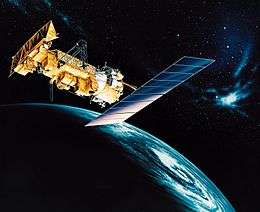NOAA-8
NOAA-8, also known as NOAA-E, was a U.S. weather satellite operated by the National Oceanic and Atmospheric Administration (NOAA) for use in the National Environmental Satellite Data and Information Service (NESDIS). It was first of the Advanced TIROS-N series of satellites.[3]
| Mission type | Weather |
|---|---|
| Operator | NOAA |
| COSPAR ID | 1983-022A |
| SATCAT no. | 13923 |
| Spacecraft properties | |
| Manufacturer | GE Astrospace |
| Launch mass | 3,130 lb (1,420 kg) |
| Dry mass | 1,630 lb (740 kg) |
| Start of mission | |
| Launch date | March 28, 1983 15:52 UTC |
| Rocket | Atlas-E Star-37S-ISS |
| Launch site | Vandenberg SLC-3W |
| End of mission | |
| Disposal | Decommissioned |
| Last contact | December 29, 1985[1] |
| Orbital parameters | |
| Reference system | Geocentric |
| Regime | Sun-synchronous |
| Semi-major axis | 7,174 kilometers (4,458 mi)[2] |
| Perigee altitude | 813.3 kilometers (505.4 mi)[2] |
| Apogee altitude | 793.1 kilometers (492.8 mi)[2] |
| Inclination | 98.6°[2] |
| Period | 100.8 minutes[2] |
| Epoch | 16 May 2020[2] |
Advanced TIROS-N | |
NOAA-8 was launched on an Atlas E rocket on March 28, 1983 from Vandenberg Air Force Base.[4] The last contact occurred on December 29, 1985,[5] following a power failure caused by thermal runaway of its battery system.[6]
Specifications
Instruments
- Argos (ARGOS Data Collection System)
- AVHRR (Advanced Very High Resolution Radiometer)
- HIRS/2 (High-resolution InfraRed Sounder/2)
- MSU (Microwave Sounding Unit)
- S&RSAT (Search and Rescue Satellite Aided Tracking System)
- SSU (Stratospheric Sounding Unit)
- SEM/MEPED (SEM/Medium energy proton detector)
- SEM/TED (SEM/Total Energy Detector)[5]
References
- World Meteorological Organization (July 28, 2015). "Satellite: NOAA-8". WMO OSCAR. Retrieved May 16, 2020.
- N2yo.com. "NOAA 8". Retrieved May 16, 2020.
- NASA, Goddard Space Flight Center. "NOAA-8". NSSDCA. Retrieved July 3, 2018.
- Herbert J. Kramer (2002). Observation of the Earth and Its Environment: Survey of Missions and Sensors. Springer Science & Business Media. pp. 739–. ISBN 978-3-540-42388-1.
- "Satellite: NOAA-8". World Meteorological Organization. July 28, 2015. Retrieved July 3, 2018.
- Bill Sweetman; Kimberley Ebner (June 1, 2007). Jane's Space Systems and Industry. Jane's Information Group. ISBN 978-0-7106-2813-8.
- United States. National Aeronautics and Space Administration (1991). NASA Pocket Statistics. NASA.
This article is issued from Wikipedia. The text is licensed under Creative Commons - Attribution - Sharealike. Additional terms may apply for the media files.
